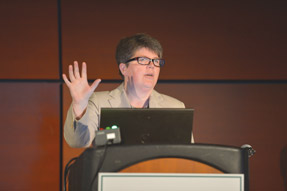1975-1984: The Cold War touches the globe and the College
ACP's seventh decade witnesses an increase in geopolitics and its impact on medicine as well as the role that other specialties would play in primary care.
The College's seventh decade was marked by cold wars and computerization, inside American medicine and within society generally.
Just 5 years after President Richard Nixon first went to China, ACP did, too. Robert H. Moser, MD, MACP, who became executive vice president (EVP) of the College in 1977, spent almost a month meeting with and speaking to Chinese physicians that summer.
“All audiences remained scrupulously alert and attentive—despite auditoriums that ranged from stifling to frigid. I had the sense that it would have been a political-social sin to fall asleep during a lecture, regardless of how boring or incomprehensible,” he reported. In return, the Chinese impressed him with their advances in burn management, salvage of amputated limbs, and acupuncture analgesia.
The geopolitical situation was a little less promising in other parts of the world. Dr. Moser's visit to Panama revealed that Central American trainees were finding it difficult to get fellowships in the U.S. and instead “were being lured to Cuba, East Germany, Poland, and the USSR.” In an understated aside, Dr. Moser reported, “It was also during this meeting that Mrs. Moser, Dr. Hook, and myself were assaulted by street thieves and received some minor knife wounds.”
No knives were pulled, but the turf war between the College and the American Society of Internal Medicine (ASIM) was getting heated enough for Dr. Moser to compare it to a bloodier conflict. “ASIM continued to deny ACP emergence into the arena of medical socioeconomics. It reminded me of the familiar denial by the [Palestine Liberation Organization] that the state of Israel existed,” he wrote. ACP built a new fort in the battle to represent internal medicine, opening a Washington, D.C., office in 1981.
The questions about spheres of influence extended to other physician specialties. “Primary care” was gaining ground as an organizing principle in health care, but College leaders debated whether that meant family physicians should be included in the organization.
Although in 1971 College leaders had noted the potential need for physicians trained in emergency medicine, they were certain that emergency physicians didn't need their own board and training programs. The Board of Governors in 1976 found that “It would be harmful if emergency facilities fell under the exclusive administration of another medical specialty,” according to former College EVP Edward C. Rosenow Jr., MD, MACP.
All of these medical specialties were united in their opposition to referring patients to chiropractors, which resulted in an anti-trust suit by a chiropractor named Chester A. Wilk against the College, the American Medical Association (AMA), and other medical organizations. The famous lawsuit went on for decades, with the AMA eventually losing, although the College had already been dismissed as a defendant.
Speaking of issues that were not going to be solved soon, in 1976, Dr. Rosenow “reminded the Board that a final challenge to the College was beginning to surface in the United States: Total health resources were finite, and someone would soon be faced with making important priority decisions about how these limited resources should be distributed, such as setting up criteria for patient selections for renal dialysis and open heart surgery.” In 1980, the College's new Ad Hoc Committee on Cost Containment developed a manual and a video to try to help residents practice more cost-effective care.
Addressing another issue in residency, the College participated in efforts to include subspecialty fellowships within the authority of the Residency Review Committee on Internal Medicine, which had previously been a “haphazard process” of old boys' networking, according to Dr. Moser.
“Most of the ‘deals' were consummated traditionally on the boardwalks in front of the old Haddon Hall [in Atlantic City] during the heyday of the research society meetings. They earmarked and swapped good house officers and fellows,” he described, adding that he wasn't sure the new system would work due to “program directors who see no advantage to joining the hoi polloi in the match.”
The good old boys weren't very excited about moving into the computer age, either. Some College leaders had visions of the potential, such as ACP President Jack D. Myers, MD, MACP, who spoke to the 1977 Annual Session about his plans to develop what we now call clinical decision support. But, in 1984, ACP launched an e-mail network for staff and Regents, and it got so little use that plans to add the Governors to the network were abandoned.
Some things change, but others stay remarkably constant. In 1983, ACP began to discuss with the American College of Surgeons whether the proposed ICD-10, which was then scheduled to debut in 1988, might not be the ideal system for medical recordkeeping. They planned to establish an alternative, the Commission on Clinical Nomenclature Coding and Classification, which “would utilize modem computer technology to establish a ‘realistic, clinically useful’ system to classify and code diseases and procedures,” according to Dr. Moser.




